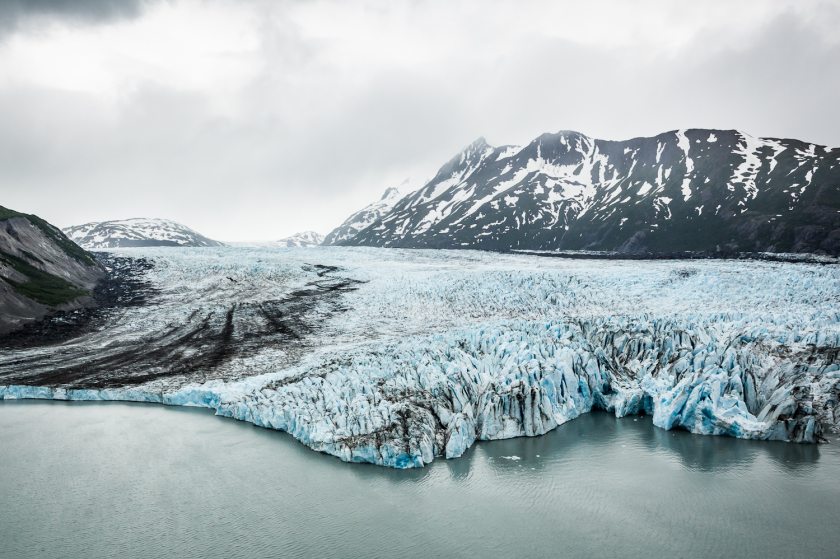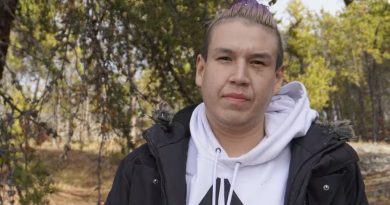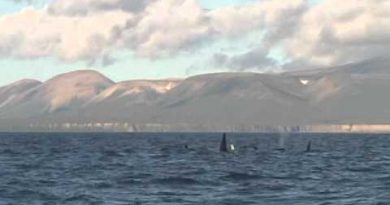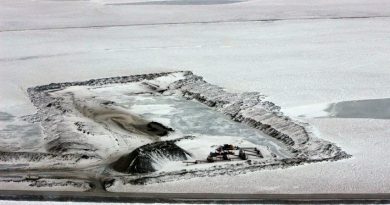IDs made in 1952 Alaska plane crash

Recent news that the remains of some of the service members who perished in a 1952 military plane crash in Southcentral Alaska had been identified brought closure to some family members of the deceased, while others struggled with the bittersweet realization that their lost family members would not yet be brought home.
Brian Gorman, whose uncle Col. Eugene Smith was among the 17 service members identified Wednesday, said his family is excited to bring closure to the old story about “Uncle Gene.”
“We’re bringing him home,” Gorman said from Delaware on Wednesday.
His uncle died in the crash on Nov. 22, 1952, when a C-124 Globemaster — a massive cargo and crew transport plane — en route to Elmendorf Air Force Base from Washington state crashed into Mount Gannett above Colony Glacier during bad weather.
All 52 people aboard perished in the crash. The wreckage was discovered six days later, on Nov. 28, 1952, but was eventually lost in the grumbling movement of the Colony Glacier, about 50 miles east of Anchorage.
Sixty years later, the plane wreckage was spotted from the air during a National Guard training exercise on June 10, 2012.
Officials from the Joint POW/MIA Accounting Command were deployed to the glacier that summer with hopes of bringing back artifacts from the crash and human remains that could be tied to specific service members known to have been aboard the plane.
JPAC returned the next summer and mounted a second debris recovery effort. Meanwhile, family members of those lost in the crash waited anxiously for news that their relatives might be among those whose remains were recovered at the site.
JPAC was back in Alaska when the announcement was made Wednesday, said Maj. Jamie Dobson, JPAC spokesperson. She said crews were “collecting material evidence and possible remains” on the glacier, but “as always, we have to get it back to the lab to make sure it’s associated” with the crash.
She said the team would be in Alaska for roughly one more week.
‘A little closure on the story’
Gorman said he received word roughly a month ago that his uncle was one of the 17 identified.
“Through whatever kind of luck and the gods, (Uncle Gene) was one of them,” Gorman said.
“We’re all pretty excited about it,” Gorman said of his family, which includes Smith’s nine nephews and nieces.
Gorman never knew his uncle, but “as a family his memories were kept alive by the stories of our mothers and uncle,” he said. He was known as a war hero and World War II investigator, Gorman said.
After receiving word of the identification, Gorman and his cousin drove to Dover Air Force Base in Delaware, where they met with a mortuary specialist, who presented Gorman with a binder of all the findings and history of the crash.
On July 24, Gorman and his cousin will fly to Honolulu, where JPAC is based, to receive the remains.
A full-sized coffin will hold the remains — a piece of his uncle’s skull — along with a full military uniform, Gorman said. A U.S. Air Force colonel will accompany Gorman back to Philadelphia.
The family will then have a burial service, where Gorman’s uncle will be laid to rest in the family plot, next to his parents and some of his siblings.
“Being able to bring him home kind of puts a little closure to the story,” Gorman said.
“We’re hoping that the rest of the members of that flight will someday soon be identified and come home,” he added.
For some in the family, identification of the remains came a bit too late. In August 2012, Gorman’s aunt Peg — Gene Smith’s sister — passed away. Gorman’s uncle Mike, the last of Gene’s siblings, passed away almost exactly one year before receiving word of the positive identification, Gorman said.
‘Bittersweet,’ ‘overwhelming’ news
Tonja Anderson’s grandfather, Isaac Anderson, was also killed in the crash. Her grandfather’s remains were not among those identified on Wednesday.
She said from Florida that the news was “bittersweet” and “overwhelming.”
Anderson has worked tirelessly to bring families of the crash together and is the administrator of a Facebook page dedicated to families of those who died in the crash. Since the plane was discovered in 2012, she has continued to push JPAC to search for the missing service members on the glacier.
This summer, Anderson will be attending the funeral services of several of the families with whom she has built relationships over the past few years.
“I will continue to reach out … and push the government to go back and still go searching,” she said.
Anderson said that if her grandfather had been among the 17 to be identified, she may have stopped fighting for the other service members who have yet to be found. She believes God is sending a message that “I’m not ready to give him to you; I need to continue to fight,” she said.
“And that’s what I will do,” Anderson said.
The 17 service members that were recovered were listed in a Department of Defense press release as follows:
U.S. Army Lt. Col. Lawrence S. Singleton, Pvt. James Green Jr., and Pvt. Leonard A. Kittle; U.S. Marine Corps Maj. Earl J. Stearns; U.S. Navy Cmdr. Albert J. Seeboth; U.S. Air Force Col. Noel E. Hoblit, Col. Eugene Smith, Capt. Robert W. Turnbull, 1st Lt. Donald Sheda, 1st Lt. William L. Turner, Tech. Sgt. Engolf W. Hagen, Staff Sgt. James H. Ray, Airman 1st Class Marion E. Hooton, Airman 2nd Class Carroll R. Dyer, Airman 2nd Class Thomas S. Lyons, Airman 2nd Class Thomas C. Thigpen, and Airman 3rd Class Howard E. Martin.
The remains will be recovered and returned to their families for burial with full military honors, according to the release.
Contact Laurel Andrews at laurel@alaskadispatch.com or on Google+
Related stories from around the North:
Canada: First Air has ‘taken definite lessons’ from deadly Arctic plane crash, CBC News
Norway: The tyranny of time and distance in Arctic SAR, Blog by Mia Bennett
Russia: MH370: What if it were to happen in the Arctic?, Blog by Mia Bennett
United States: Crews unearth military history on Alaska Glacier, Alaska Dispatch



